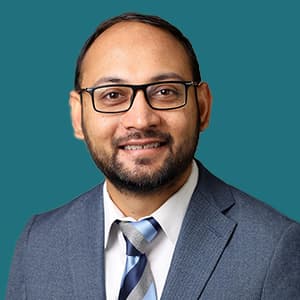Evaluating Poseida Therapeutics' P-BCMA-ALLO1 With Optimized Lymphodepletion in R/R Myeloma
Bhagirathbhai R. Dholaria, MD, an associate professor of medicine in malignant hematology & stem cell transplantation at Vanderbilt University Medical Center, discussed new results presented at Tandem 2025.
Bhagirathbhai R. Dholaria, MD

Poseida Therapeutics is currently evaluating P-BCMA-ALLO1, an allogeneic BCMA-directed chimeric antigen receptor T-cell (CAR-T) therapy, in an ongoing phase 1/1b clinical trial (NCT04960579) for the treatment of relapsed/refractory (r/r) multiple myeloma (MM). At the 2025 Tandem Meetings |Transplantation & Cellular Therapy Meetings of ASTCT and CIBMTR, held in Honolulu, Hawaii, February 12 to 15, 2025, the company gave a presentation focused on findings from the study's optimized lymphodepletion cohort (Arm C), which included patients with r/r MM who had been previously treated with at least 3 prior lines of therapy, including a proteasome inhibitor, an immunomodulatory drug, and an antiCD38 monoclonal antibody.
During the conference, CGTLive®'s sister site OncLive®, interviewed Bhagirathbhai R. Dholaria, MD, an associate professor of medicine in malignant hematology & stem cell transplantation at Vanderbilt University Medical Center, about the data. He went over some of the key safety and efficacy results presented, highlighting that patients who were naive to BCMA-directed therapy (n = 16) achieved an overall response rate (ORR) of 100% .
OncLive: Can you discuss the safety findings for P-BCMA-ALLO1 seen in the new data?
Bhagirathbhai R. Dholaria, MD: I think the most important take-home message in terms of the safety of the cohort see is that we did not report any grade 3 or higher cytokines release syndrome (CRS) or immune-effector cell associated neurotoxicity syndrome (ICANS). We actually didn't experience any patient with Parkinsonism or other movement disorders, which has been described with other autologous BCMA-targeting CAR T-cell therapy. There were also no cases of hemophagocytic lymphohistiocytosis (HLH) reported in this study. The overall incidence of CRS was around 42% and almost all these events were grade 1 or grade 2. The neurotoxicity was reported in around 14% of the patients, and almost all of them were grade 1 neurotoxicity, which quickly resolved with minimal steroids.
Can you go over the efficacy results?
We do have some preliminary efficacy data in Arm C. A total of 32 patients were evaluable for efficacy. The ORR was around 88%. Now, looking at the different subgroups of patients that were treated in this study, in the BCMA-naive patient cohort (n = 16), 100% of the patients had a response. For patients who had had 1 or more prior BCMA-targeted therapy, 75% of patients responded. For patients who had had both a BCMA-targeted therapy as well as a GPRC5D-targeted therapy such as talquetamab—we had 9 patients in that group—78% of the patients responded to P-BCMA-ALLO1 therapy.
The follow-up is rather short for these remissions. We have full data from the older Arms A and B, where median duration of response is 214 days. However, the follow-up in Arm C, which is part of this current presentation, is rather short, so we don't have the full data on duration of response here.
The responses were rapid. In fact, most patients had a response at the first disease evaluation, which is around 2 weeks after the CAR T-cell infusion. We noticed that in vivo, these cells expanded within the first 7 to 10 days after the infusion, and by month 3 or 4, most of these CAR T-cells had disappeared, except in a handful of patients, where we see even longer in vivo persistence, mainly in the bone marrow, even after this CAR-T disappeared from the peripheral blood circulation.
This transcript has been edited for clarity.